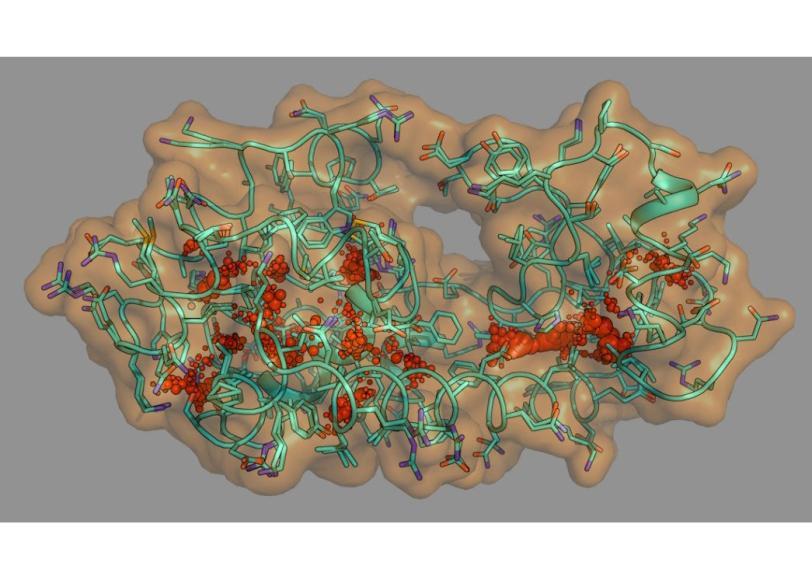Proteins Better Analyzed at Room Temperature, Report Finds
Proteins are jittery things – continually moving, flopping around and waving their molecular arms.
By Glennda Chui
Proteins are jittery things – continually moving, flopping around and waving their molecular arms. These changes in position, known as conformations, are essential to how they do their jobs in the cells of every living thing.
But the practice of freezing protein crystals for analysis – a mainstay of biology for 40 years – erases most of the information about these motions, leading scientists to miss vital clues about how these molecules operate, according to a report by researchers at SLAC, Lawrence Berkeley National Laboratory, UC-Berkeley and UC-San Francisco in this week’s early edition of the Proceedings of the National Academy of Sciences.
The best way to catch a protein in all its many positions, they assert, is to analyze it at room temperature – an approach made easier by technological advances over the past decade at facilities like SLAC’s Stanford Synchrotron Radiation Lightsource and Berkeley’s Advanced Light Source, where these studies take place.
“Millions, trillions, quadrillions – there are more conformations in a protein than the number of atoms in the universe,” said Tom Alber of Berkeley Lab, the principal investigator of the study. “What this paper says is that if you are interested in functional motions of protein molecules, here’s how you can detect them. All of a sudden a whole new world will open up to you.”
The basic method for studying protein structure, called protein crystallography, has been a tremendous boon for biology. Over the past six decades, biologists have used it to determine the structures of more than 65,000 proteins that perform every sort of function in living things, from photosynthesis in plants to fending off illness in people.
Because proteins are large, unwieldy molecules, their structures are hard to analyze. So scientists induce many copies of a protein to form into crystals in which the orderly arrangement of the molecules makes it easier to analyze them with X-rays from a synchrotron. The X-rays scatter off the electrons in the protein molecules and bounce into a detector, producing a diffraction pattern that researchers use to recreate the protein structure.
More than 95 percent of the proteins whose structures have been determined over the years were frozen in liquid nitrogen before analysis. This made the fragile, jelly-like crystals much easier to store and transport, and helped protect them against damage from the X-ray beam. And it didn’t look like the freezing process itself did any harm. “Previously people thought if you freeze a crystal fast enough, any change will be insignificant,” said Henry van den Bedem, a researcher with the Joint Center for Structural Genomics at the SSRL. “But that turns out not to be the case.”
James S. Fraser, a graduate student in Alber’s lab who is now at UCSF, suggested that looking at proteins at room temperature might yield a very different picture. He launched a series of studies aimed at finding out.
For this particular study, Fraser, Alber, van den Bedem and their colleagues compared structural data that had been obtained on frozen crystals and room-temperature crystals of 30 different proteins.
They used two new computational tools – "qFit," developed by van den Bedem at SLAC, and "Ringer," developed primarily by Terry Lang in Alber’s lab at UC-Berkeley – to look for subtle patterns in the data that reveal fleeting variations in the positions of the protein’s side chains, which branch off its main chain of atoms like ribs off a backbone.
The result: Flash freezing had squeezed the proteins and made them less flexible, in the process changing the positions of more than 35 percent of the side chains compared to where they were at room temperature. Further, the side chains that flopped around the most when moving freely in a liquid solution – and that therefore were likely to be most active in the protein’s work – were the most restricted by freezing.
“Collecting X-ray data at room temperature allowed us to connect the protein’s structural fluctuations in the crystal with functional motions that occur in solution,” Fraser said.
Alber said analyzing room-temperature protein crystals is a lot more feasible than it was a decade ago. Advances in preparing crystals have made them sturdier, and X-ray exposures are much shorter. So it may be time for room-temperature analysis to undergo a renaissance.
As for his team, he said they are pursuing the new approach at “2,000 miles per hour. Everything we touch, we get new information,” Alber said. “It’s been a gold mine.”

(Image courtesy James Fraser)